
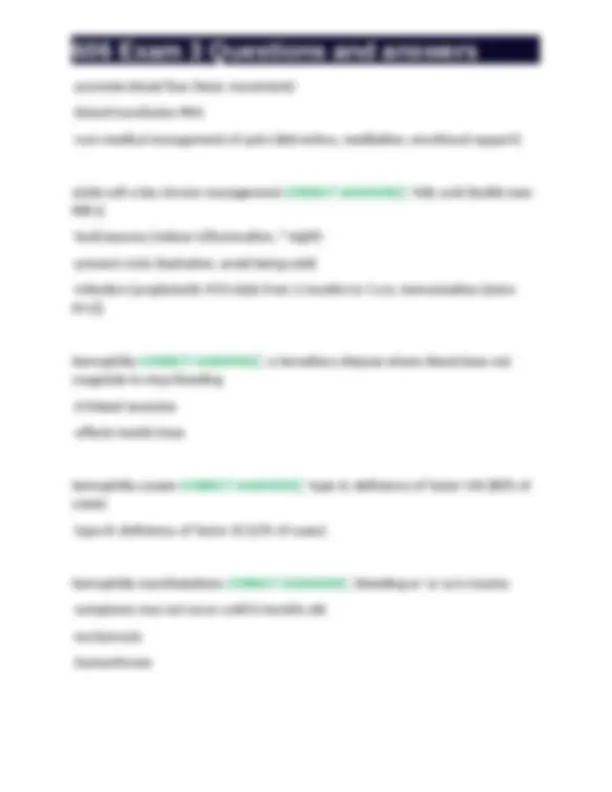
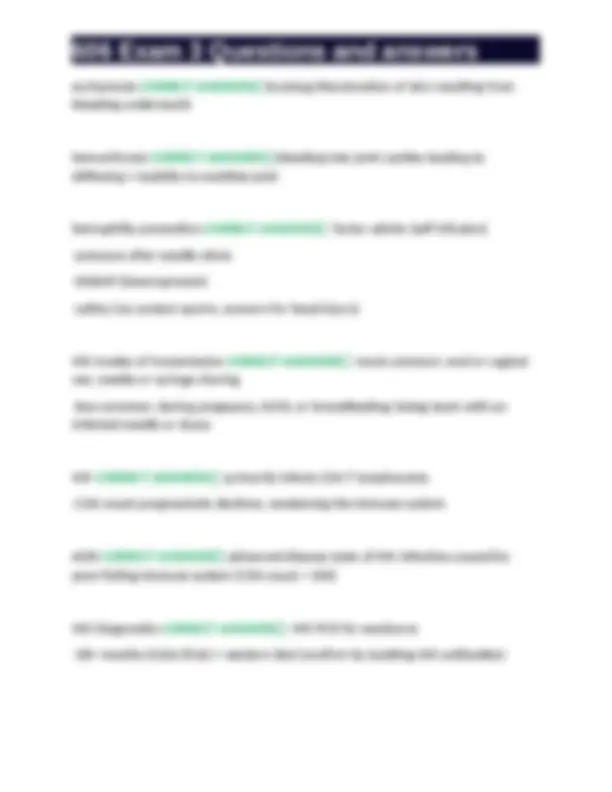
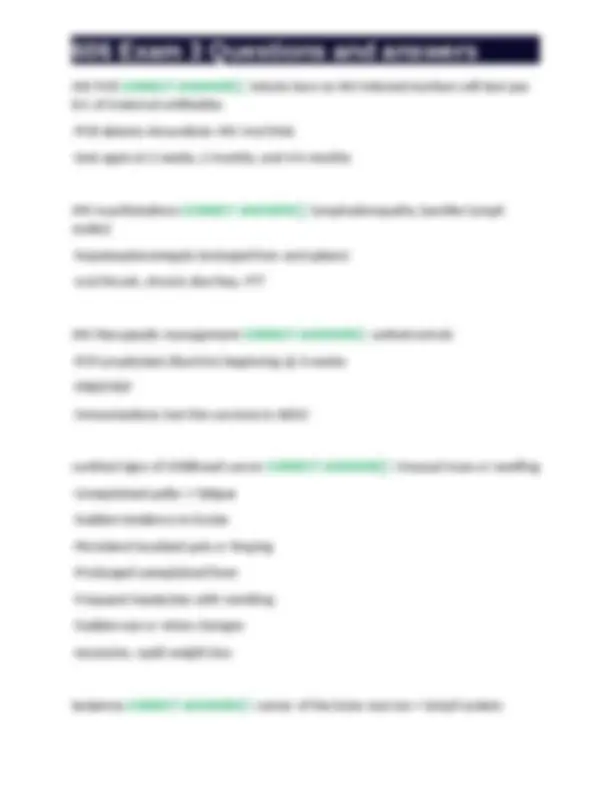
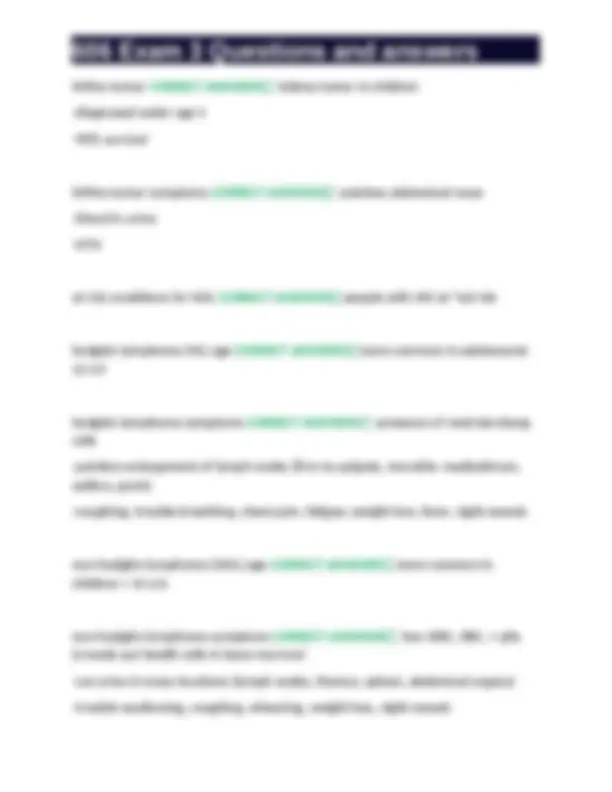
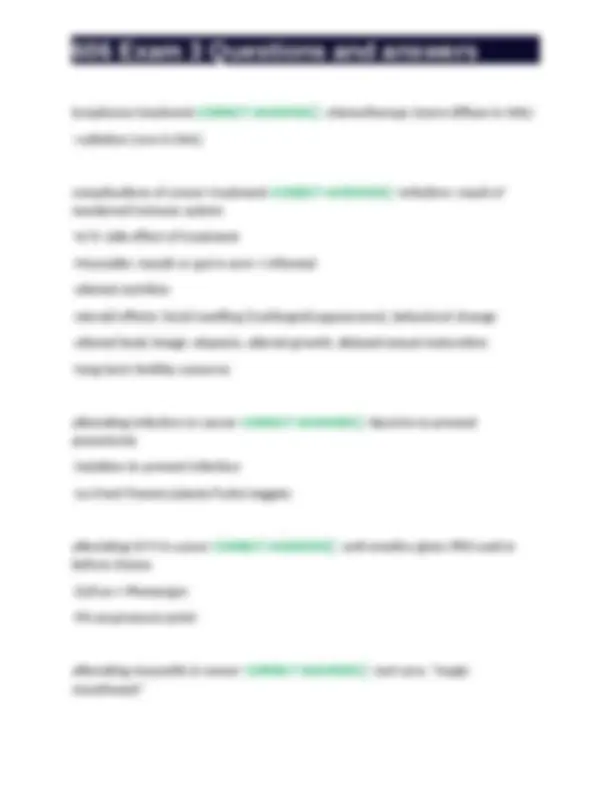
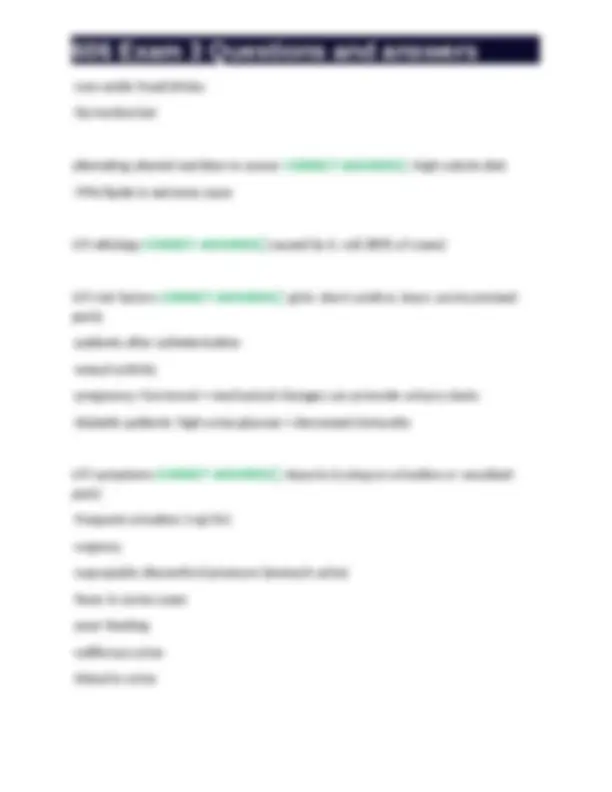
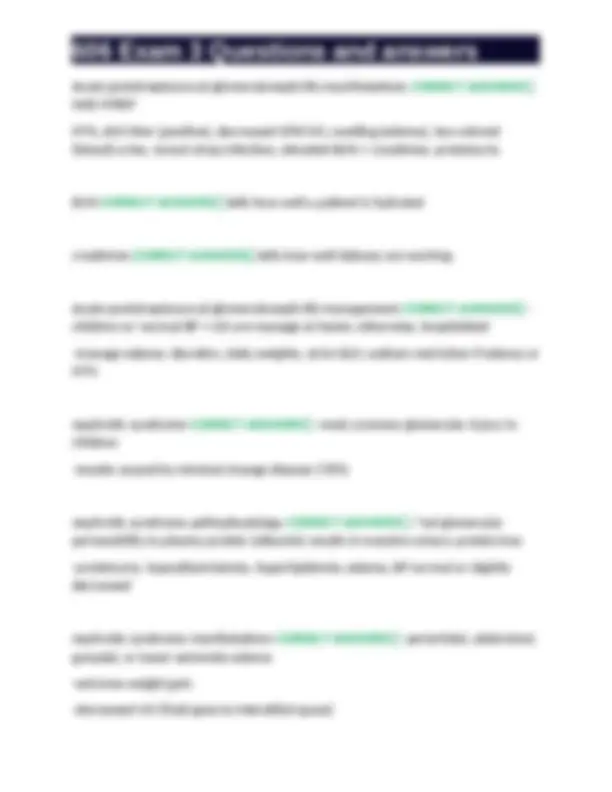
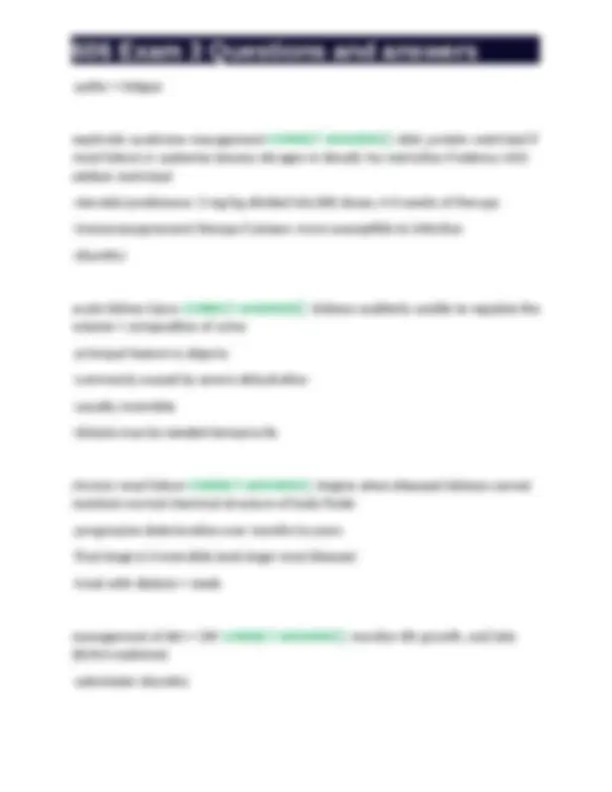
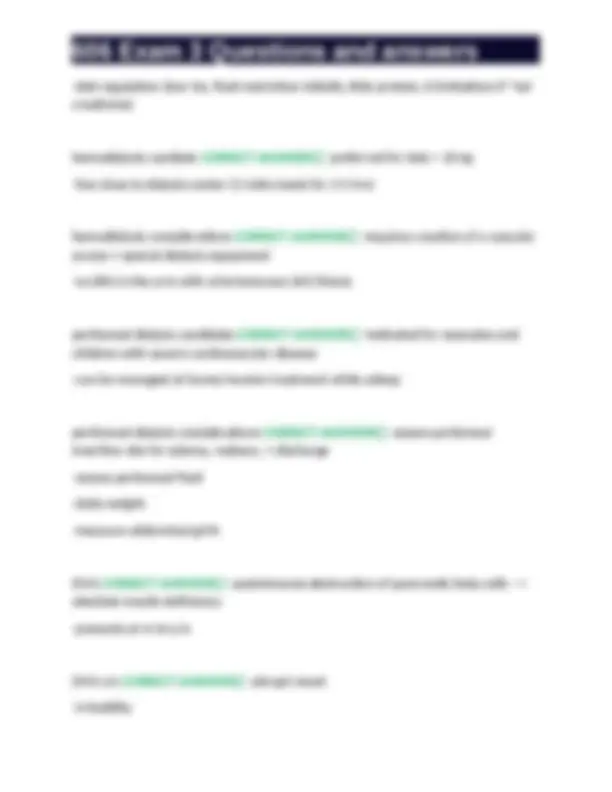


Study with the several resources on Docsity

Earn points by helping other students or get them with a premium plan


Prepare for your exams
Study with the several resources on Docsity

Earn points to download
Earn points by helping other students or get them with a premium plan
Community
Ask the community for help and clear up your study doubts
Discover the best universities in your country according to Docsity users
Free resources
Download our free guides on studying techniques, anxiety management strategies, and thesis advice from Docsity tutors
Comprehensive information about hemophilia, a hereditary disease that affects blood coagulation, including its types, manifestations, prevention, and treatment. It also covers related topics such as hiv, leukemia, brain tumors, and bone cancer, discussing their modes of transmission, symptoms, diagnosis, and management.
Typology: Exams
1 / 17

This page cannot be seen from the preview
Don't miss anything!










anemia CORRECT ANSWERS✅ decreased number of RBCs and decreased O2- carrying capacity anemia causes CORRECT ANSWERS✅ -inadequate RBC production -^ed RBC destruction -excessive RBC loss -nutritional deficiency (inadequate Fe consumption, excess milk consumption) anemia s/s CORRECT ANSWERS✅ -fatigue -pallor (conjunctiva, palms, mucous membranes) -tachycardia -systolic heart murmur (turbulence) -cyanosis -delayed/slowed growth anemia diagnostic evaluation CORRECT ANSWERS✅ -routine screening @ 9 months -Hgb electrophoresis -CBC (decreased RBC, Hgb + Hct) [Hgb < 10 g/dL] anemia therapeutic management CORRECT ANSWERS✅ -treat underlying cause: transfusion, meds (Procrit), nutritional intervention, vitamins supplement -supportive care: O2, IV fluids, bed rest admin of oral Fe CORRECT ANSWERS✅ -give with vit C to ^ absorption
-avoid taking with milk (decreases absorption) -give 1 hr before or 2 hrs after milk -brush teeth after oral Fe -use straw to prevent staining -can turn stool black or green transfusion adverse reactions CORRECT ANSWERS✅ -monitor during and after transfusion -chills, fever, change in vitals, pruritis/urticaria, dyspnea, pain (back or head), change in patient status sickle cell disease manifestations CORRECT ANSWERS✅ -normal HR + RR -watching TV/phone (distraction) -asking for specific drugs that work for them sickle cell disease diagnosis/screening CORRECT ANSWERS✅ -Hgb electrophoresis -newborn screening in most states -genetic testing -sickle cell turbidity test (Sickledex) finger-prick test (does not distinguish between trait and disease) sickle cell crisis acute management CORRECT ANSWERS✅ -IV fluids -O2 for comfort or PRN -IV non-steroid anti-inflammatory (Toradol) -pain management (PCA pump)
ecchymosis CORRECT ANSWERS✅ bruising/discoloration of skin resulting from bleeding underneath hemarthrosis CORRECT ANSWERS✅ bleeding into joint cavities leading to stiffening + inability to mobilize joint hemophilia prevention CORRECT ANSWERS✅ -factor admin (self-infusion) -pressure after needle sticks -DDAVP (Desmopressin) -safety (no contact sports, concern for head injury) HIV modes of transmission CORRECT ANSWERS✅ -most common: anal or vaginal sex; needle or syringe sharing -less common: during pregnancy, birth, or breastfeeding; being stuck with an infected needle or sharp HIV CORRECT ANSWERS✅ -primarily infects CD4 T lymphocytes -CD4 count progressively declines, weakening the immune system AIDS CORRECT ANSWERS✅ advanced disease state of HIV infection caused by poor/failing immune system (CD4 count < 200) HIV Diagnostics CORRECT ANSWERS✅ -HIV PCR for newborns -18+ months ELISA (first) + western blot (confirm by isolating HIV antibodies)
HIV PCR CORRECT ANSWERS✅ -infants born to HIV infected mothers will test pos b/c of maternal antibodies -PCR detects intracellular HIV viral DNA -test again at 2 weeks, 2 months, and 4-6 months HIV manifestations CORRECT ANSWERS✅ -lymphadenopathy (swollen lymph nodes) -hepatosplenomegaly (enlarged liver and spleen) -oral thrush, chronic diarrhea, FTT HIV therapeutic management CORRECT ANSWERS✅ -antiretrovirals -PCP prophylaxis (Bactrim) beginning @ 6 weeks -PREP/PEP -immunizations (not live vaccines in AIDS) cardinal signs of childhood cancer CORRECT ANSWERS✅ -Unusual mass or swelling -Unexplained pallor + fatigue -Sudden tendency to bruise -Persistent localized pain or limping -Prolonged unexplained fever -Frequent headaches with vomiting -Sudden eye or vision changes -excessive, rapid weight loss leukemia CORRECT ANSWERS✅ -cancer of the bone marrow + lymph system
leukemia management CORRECT ANSWERS✅ chemotherapy, sometimes bone marrow transplant brain tumor symptoms CORRECT ANSWERS✅ -can arise from any cell in cranium -present with varying complaints -monitor for signs of ^ed ICP brain tumor treatment CORRECT ANSWERS✅ -diagnostic imaging -surgical resection (craniotomy) osteosarcoma CORRECT ANSWERS✅ bone cancer that begins in the cells that form bones; most often found in long bones Ewing sarcoma CORRECT ANSWERS✅ type of cancer that occurs in bones or in the soft tissue around the bones; most often begins in leg bones + the pelvis symptoms of bone cancer CORRECT ANSWERS✅ -bone pain -swelling -fever -unexplained fracture bone cancer treatment CORRECT ANSWERS✅ -chemotherapy + radiation -limb salvage surgery -amputation if necessary
Wilms tumor CORRECT ANSWERS✅ -kidney tumor in children -diagnosed under age 5 -90% survival Wilms tumor symptoms CORRECT ANSWERS✅ -painless abdominal mass -blood in urine -HTN at risk conditions for NHL CORRECT ANSWERS✅ people with HIV at ^ed risk hodgkin lymphoma (HL) age CORRECT ANSWERS✅ more common in adolescents 15- hodgkin lymphoma symptoms CORRECT ANSWERS✅ -presence of reed sternberg cells -painless enlargement of lymph nodes (firm to palpate, movable: mediastinum, axillary, groin) -coughing, trouble breathing, chest pain, fatigue, weight loss, fever, night sweats non-hodgkin lymphoma (NHL) age CORRECT ANSWERS✅ more common in children < 14 y/o non-hodgkin lymphoma symptoms CORRECT ANSWERS✅ -low WBC, RBC, + plts (crowds out health cells in bone marrow) -can arise in many locations (lymph nodes, thymus, spleen, abdominal organs) -trouble swallowing, coughing, wheezing, weight loss, night sweats
-non-acidic food/drinks -lip moisturizer alleviating altered nutrition in cancer CORRECT ANSWERS✅ -high calorie diet -TPN/lipids in extreme cases UTI etiology CORRECT ANSWERS✅ caused by E. coli (80% of cases) UTI risk factors CORRECT ANSWERS✅ -girls: short urethra; boys: uncircumcised penis -patients after catheterization -sexual activity -pregnancy: hormonal + mechanical changes can promote urinary stasis -diabetic patients: high urine glucose + decreased immunity UTI symptoms CORRECT ANSWERS✅ -dysuria (crying on urination or vocalized pain) -frequent urination (>q2/hr) -urgency -suprapubic discomfort/pressure (stomach ache) -fever in some cases -poor feeding -odiferous urine -blood in urine
UTI in 0-2 month old CORRECT ANSWERS✅ -fever -poor feeding -vomiting -irritability -FTT UTI diagnostic tests CORRECT ANSWERS✅ -straight/in-out cath: preferred sample -U bad for collection from child: not used for infections -clean catch: outpatient for older child UTI drug therapy CORRECT ANSWERS✅ -abx treatment based on culture and sensitivity -Bactrim (sulfa allergy, SJS) -amoxicillin, Keflex -pyridium (OTC + prescribed) about pyridium CORRECT ANSWERS✅ -provides soothing effect on urinary tract mucosa -stains urine reddish-orange (mistaken for blood) -effective in relieving discomfort Vesicoureteral reflux (VUR) pathophysiology CORRECT ANSWERS✅ -retrograde/backward flow of bladder urine into ureters + potentially to kidneys -a/w acute pyelonephritis, urosepsis, renal scarring, and deterioration of kidney function
Acute poststreptococcal glomerulonephritis manifestations CORRECT ANSWERS✅ HAD STREP HTN, ASO titer (positive), decreased GFR/UO, swelling (edema), tea-colored (blood) urine, recent strep infection, elevated BUN + creatinine, proteinuria BUN CORRECT ANSWERS✅ tells how well a patient is hydrated creatinine CORRECT ANSWERS✅ tells how well kidneys are working Acute poststreptococcal glomerulonephritis management CORRECT ANSWERS✅ - children w/ normal BP + UO are manage at home; otherwise, hospitalized -manage edema: diuretics, daily weights, strict I&O, sodium restriction if edema or HTN nephrotic syndrome CORRECT ANSWERS✅ -most common glomerular injury in children -mostly caused by minimal change disease (76%) nephrotic syndrome pathophysiology CORRECT ANSWERS✅ -^ed glomerular permeability to plasma protein (albumin) results in massive urinary protein loss -proteinuria, hypoalbuminemia, hyperlipidemia, edema, BP normal or slightly decreased nephrotic syndrome manifestations CORRECT ANSWERS✅ -periorbital, abdominal, gonadal, or lower extremity edema -extreme weight gain -decreased UO (fluid goes to interstitial space)
-pallor + fatigue nephrotic syndrome management CORRECT ANSWERS✅ -diet: protein restricted if renal failure or azotemia (excess nitrogen in blood); Na restriction if edema; H2O seldom restricted -steroids/prednisone: 2 mg/kg divided into BID doses; 4-6 weeks of therapy -immunosuppressant therapy/Cytoxan: more susceptible to infection -diuretics acute kidney injury CORRECT ANSWERS✅ -kidneys suddenly unable to regulate the volume + composition of urine -principal feature is oliguria -commonly caused by severe dehydration -usually reversible -dialysis may be needed temporarily chronic renal failure CORRECT ANSWERS✅ -begins when diseased kidneys cannot maintain normal chemical structure of body fluids -progressive deterioration over months to years -final stage is irreversible (end stage renal disease) -treat with dialysis + meds management of AKI + CRF CORRECT ANSWERS✅ -monitor BP, growth, and labs (BUN/creatinine) -administer diuretics
-rapid weight loss -fatigue general DM s/s CORRECT ANSWERS✅ polyuria, polyphagia, polydipsia DM1 treatment CORRECT ANSWERS✅ insulin (injection or pump) *urine testing for ketones (in DKA) DM2 CORRECT ANSWERS✅ -inadequate amount of insulin produced -insulin resistance -risk factor obesity DM2 s/s CORRECT ANSWERS✅ -onset is gradual -fatigue -obesity -acanthosis nigricans acanthosis nigricans CORRECT ANSWERS✅ -a/w insulin resistance -darkened/hyperpigmented, thick, velvety appearance to skin typically in nape of neck, axilla, groin, or over flexor surfaces DM2 treatment CORRECT ANSWERS✅ PO meds (metformin) + insulin PRN hypoglycemia management CORRECT ANSWERS✅ -hold insulin
-eat or drink something with sugar in it -glucagon IM or SQ diabetic ketoacidosis CORRECT ANSWERS✅ -characterized by metabolic acidosis, hyperglycemia, fluid + electrolyte shifts -occurs in newly diagnosed diabetics, insulin omission in known diabetics, and acute gastroenteritis w/ persistent vomiting diabetic ketoacidosis manifestations CORRECT ANSWERS✅ -vomiting -signs of dehydration (hypotension + tachycardia) -kussmal respirations (metabolic acidosis) -acetone odor on breath -decreased LOC -headache (cerebral edema risk)